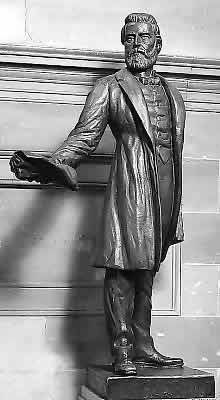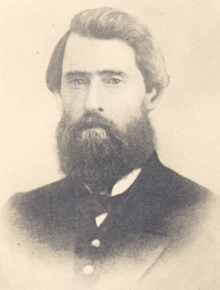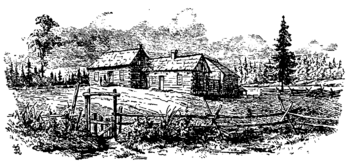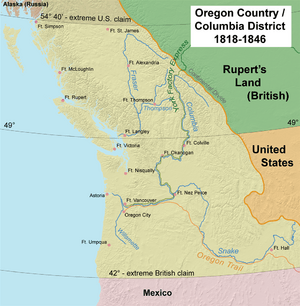Jason Lee (missionary) facts for kids
Jason Lee (born June 28, 1803 – died March 12, 1845) was a Canadian missionary. He was a pioneer in the Pacific Northwest. He helped settle the Oregon Country. Jason was born on a farm near Stanstead, Quebec.
In 1831, some Nez Perce and Bitterroot Salish people asked for the "Book of Heaven" (the Bible). Jason Lee and his nephew, Daniel Lee, decided to become missionaries for them. Their church, the Methodist Episcopal Church, sent them to start a mission among the Salish. At that time, the Pacific Northwest was shared by the United Kingdom and the United States.
In 1834, the missionaries traveled overland with Nathaniel Jarvis Wyeth, a fur trader. They arrived at Fort Vancouver and met John McLoughlin. McLoughlin suggested that Jason Lee start his mission in the Willamette Valley instead of with the Salish. Lee agreed and became the first of the Oregon missionaries. He played a big part in American settlement in the Oregon Country.
Contents
Early Life and Education
Jason Lee was the youngest of fourteen brothers and sisters. When he was 13, he started supporting himself. At 23, he became a Methodist. He later went to the Wilbraham Wesleyan Academy. He became friends with Osman Cleander Baker there and finished school in 1830.
From 1830 to 1832, he worked as a minister and teacher in the Stanstead area. Lee wanted to preach to the First Nations in Canada. He applied to a missionary group in London, but his application was not processed.
Starting the Mission
In 1832, four men from the Nez Perce and Bitterroot Salish tribes traveled to St. Louis. They asked William Clark (from the Lewis and Clark expedition) for someone to bring them the "Book of Heaven." A Christian newspaper wrote about this request. It asked people to send preachers to the Rocky Mountains and beyond.
Wilbur Fisk, the president of Wesleyan University, saw the article. He suggested that the Methodist Church start a mission among the Salish. Jason Lee, who had been Fisk's student, and his nephew Daniel volunteered.
They arranged to travel with Nathaniel Jarvis Wyeth's group. In early 1834, they left Independence, Missouri. As they traveled, Lee compared different Native American cultures. He thought the Walla Walla were "far more filthy and indolent" than the Cayuse.
Their long journey ended at the Hudson's Bay Company's fur trading post, Fort Vancouver. The missionaries stayed there for the winter. During their stay, John McLoughlin suggested they build their mission in the nearby Willamette Valley instead of the Flathead land. Lee chose a spot northwest of where Salem, Oregon is today. He found about a dozen French-Canadian settlers living there with their Native American wives and children.
Working with Native Peoples
Jason Lee soon asked for more missionaries and helpers to be sent. He wanted to spend more time teaching and converting Native Americans. Other missionaries also felt they spent too much time on other tasks. Lee claimed that many Native Americans had become Methodists. However, it wasn't until George Abernethy arrived in 1840 that Lee could focus only on preaching to the native peoples.
Lee also noticed that Native American populations were shrinking due to disease. In 1836, he wrote that "unless the God of heaven undertake their cause, they must perish." Despite his efforts, Lee started to believe that Oregon would become a place for white settlers. In 1837, he asked the Methodist Missionary Board to send farmers. He felt that if "a few good, pious settlers" came, it would greatly benefit "generations yet unborn."
Political Activities and Settlement
Willamette Cattle Company
The first U.S. Navy officer to visit the Methodist mission was Lieutenant William A. Slacum. He met Jason Lee at Champoeg, Oregon in January. Slacum talked to the settlers about livestock. At that time, the Hudson's Bay Company owned all the cattle in Oregon. McLoughlin allowed missionaries and settlers to borrow livestock.
To solve this problem, Slacum suggested buying cattle from Alta California. The Willamette Cattle Company was formed. Slacum's ship, the Loriot, took some men to California. They returned overland with a herd of 600 cattle. This helped Lee and the Mission become self-sufficient in food.
Pushing for Settler Government
In 1841, Ewing Young died without any heirs. His large estate became a topic of discussion among settlers. Several meetings were held. Jason Lee led the first meeting. He suggested creating a single government for all settlers south of the Columbia River.
This idea came from disagreements with Vicar General François Norbert Blanchet. Blanchet had been handling legal matters for the Catholic settlers. Lee accused Blanchet of dividing the community by not joining the new government. Lee wanted to reduce the Hudson's Bay Company's influence over Catholic missionaries. The Oregon Mission also owed money to the Company. Lee supported a government in 1841 to gain more control, not just because he thought a local government was needed.
Later, during the Champoeg Meetings, Lee was less involved in politics. A biographer noted that Lee realized a local provisional government was not the best path for Oregon. Abernethy also agreed with Lee that the Champoeg Meetings were not necessary.
Trip East in 1838
It was hard to communicate with the Missionary Board in the United States. So, Lee decided to return to explain the Mission's activities in detail. Before leaving, he helped write a letter from Willamette Valley residents to the U.S. Congress. This document asked the American government to take control of the Oregon Country south of the Columbia River. It also pointed out the possibilities of trade with Asia and the Pacific.
Besides raising money for the mission, Lee wanted to promote Oregon as a good place for people to settle. He spent three weeks at missions run by Marcus Whitman and Henry H. Spalding. He saw their farms and thought they were better than those in the Willamette Valley. Sadly, his wife, Anna Maria Pittman Lee, and their baby died in June. Lee heard the news when he reached Missouri. He soon remarried Lucy Thompson Grubbs.
While traveling through Illinois, Lee convinced John P. Richmond to join him in Oregon. Richmond later became the head of the Nisqually Mission in modern Washington. In Peoria, Lee gave a speech about Oregon. Some locals were so excited that they formed the Peoria Party to try and settle Oregon.
In November, the Missionary Board approved Lee's plan. He wanted to hire more helpers like blacksmiths and mechanics. He also wanted to build a grist mill and grow more crops. The letter to Congress arrived in Washington, D.C. and was presented by Senator Lewis F. Linn in January 1839. Lee wrote to Representative Caleb Cushing that if America controlled the area, many mission helpers would become permanent settlers. This prediction came true.
Lee went on several speaking tours across the United States. He also visited his hometown in Canada to raise money. The Board decided to send five new preachers, even though Lee thought only two were needed. Lee and this "great reinforcement" sailed on the ship Lausanne. They arrived in Oregon on June 1, 1840.
Dismissal and Later Life
For several years, letters were sent to the Board of Managers from Elijah White, John P. Richmond, and Gustavus Hines. These letters criticized Lee's leadership.
Lee had conflicts with White, who managed the mission's money. Lee accused White of spending mission money at Fort Vancouver without showing records. White left for the United States in 1841. Although David Leslie gave Lee a good review, it wasn't enough to overcome years of criticism. Reports said Lee neglected and wasn't interested in converting Native Americans. Also, Lee could not provide a full financial history of the Willamette Mission.
Because of these issues, the Board appointed Rev. George Gray as the new superintendent. Gray was told to sell the mission's properties, including the grist mill and unused missions.
Lee heard the news of his dismissal from Marcus Whitman. He decided to meet the Board in person to defend himself. He traveled across Mexico and up the Mississippi River, reaching New York City on May 27, 1844. He found the church leaders arguing about slavery, which later led to a split in the church.
Meanwhile, Lee went to Washington, D.C.. He met with President John Tyler and Senator Thomas H. Benton to discuss the Oregon Mission's land claims. When he finally met with the Board, Lee was able to explain his actions. However, he was not reappointed as superintendent.
He chose to raise money for the Oregon Institute, a school he helped start (now Willamette University). While visiting his sister in Stanstead, his health failed. He died on March 12, 1845. His remains were later moved to the Lee Mission Cemetery in Salem, Oregon in 1906. His two wives and infant daughter were also reinterred there.
Legacy and Recognition

The house Jason Lee lived in during 1841 is now part of the Willamette Heritage Center.
In 1953, the State of Oregon gave a bronze statue of Lee to the United States Capitol's National Statuary Hall Collection. Another copy of the statue was placed on the grounds of the Oregon State Capitol in 1953. The sculptor, Gifford MacGregor Proctor, finished it after his father, Alexander Phimister Proctor, passed away.
Elementary schools in Richland, Washington, and Portland, Oregon are named after him. A middle school in Vancouver, Washington also carries his name.




